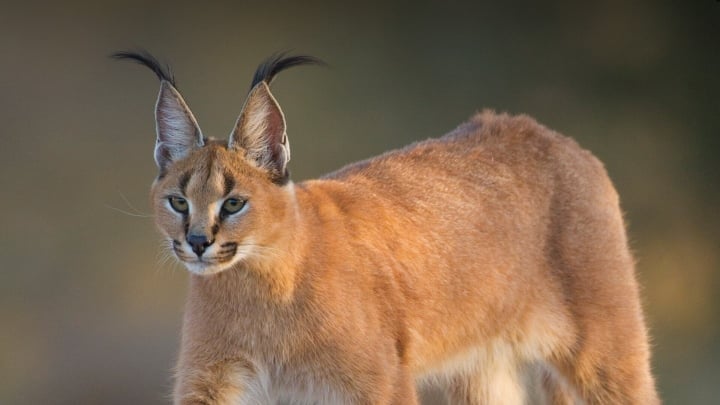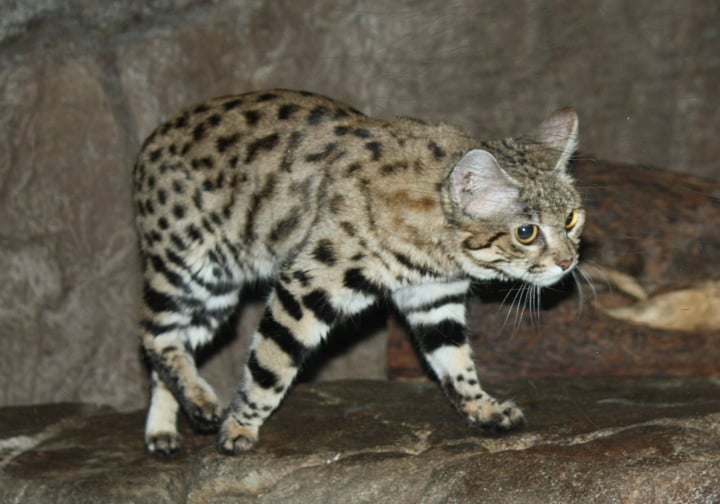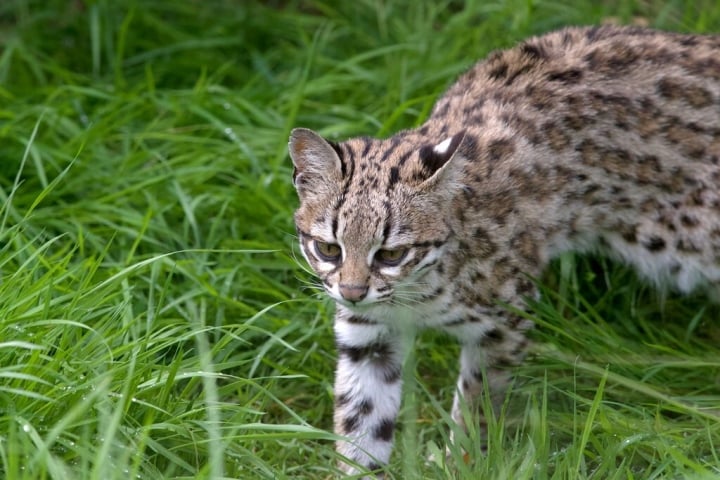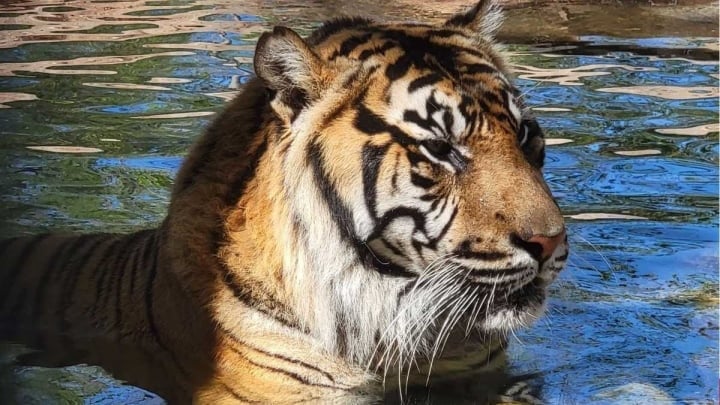The world's largest wild cats are quite diverse, most of them live on land. But contrary to the common impression of cats, some wild cats are very good swimmers and have many special habits.
Caracal

The caracal is one of the world's largest wild cats. (Photo: San Diego Zoo)
This is a cat species that exists naturally in 60 countries in Asia and Africa.
Among the felids, the caracal is a medium-sized and popular looking species, sometimes kept as a pet. The caracal has long legs, a short face, long tufted ears and long fangs. The coat is reddish-brown or sandy in color, while the belly is paler with small red patches. The body length reaches 40–50 cm and the weight reaches 8–19 kg.
The serval prefers forests, savannas, grasslands, semi-deserts and scrublands, but is particularly fond of dry areas with low rainfall and plenty of cover. They can also be found in montane habitats such as the Ethiopian Highlands.
The prairie dog can live over 20 years in captivity.
Black-footed cat Felis nigripes
The black-footed cat is found only in the savannas and grasslands of southern Africa (Botswana, Namibia, South Africa, Angola, Zimbabwe and Lesotho). The terrain where they live has an average rainfall of 100 to 500 mm per year. They nest in abandoned termite burrows or mounds and also take temporary shelter in bushes.
Among the largest wild cats in the world, the black-footed cat is the smallest of the African species. Its body is covered in light brown fur with black to dark brown spots covering its back, sides, and belly. Dark brown stripes similar to spots appear on its cheeks, forelegs, hips, and tail.
This is also a relatively long-lived cat, reaching 15.6 years in captivity. The black-footed cat's diet is quite diverse: 98% of it is mammals and birds, with mammals making up 72% and birds making up 26% of the diet. Animals weighing less than 40 g make up more than half of their prey.
The black-footed cat population is declining and it is estimated that only 9,700 individuals remain in the wild.

Black-footed cat Felis nigripes. (Photo: iNaturalist)
Leopardus geoffroyi
It is native to South America (Argentina, Brazil, Bolivia, Chile, Paraguay, Uruguay) and lives in a variety of tropical and subtropical terrestrial habitats. The habitat of one of the world's largest wild cats includes dry mountain grasslands and shrublands, coastal floodplain grasslands, savannas and wetlands, temperate grasslands, steppes and shrublands, and dry broadleaf forests. The habitat can be moist or dry and has varying vegetation densities, but still provides enough cover for the lynx to hunt effectively.
Andean mountain cat Leopardus jacobita
Along with the South American wildcat, the Andean mountain cat is found only in South America (Argentina, Bolivia, Chile, Peru). The Andean mountain cat has an ash-gray coat, with a gray head, face, and rounded ears. The nose and lips are black with white surrounds; two dark brown lines run from the corners of the eyes across the cheekbones. There are some black spots on the forelegs, yellowish-brown spots on the flanks, and up to two narrow, dark rings on the hind legs.
Adult individuals range in head-to-body length from 57.7 to 85cm with a tail length of 41.3 to 48.5cm, shoulder height about 36cm and weight up to 5.5kg.
The Andean Mountain Cat lives only at high altitudes in the Andes: from 1,800m in the southern Andes to over 4,000m in Chile, Bolivia and central Peru. This arid terrain, sparse vegetation, rocky and steep terrain suggests that the Andean Mountain Cat prefers temperate and terrestrial habitats.
Leopardus tigrinus

Leopardus tigrinus.
The Miniature Spotted Cat weighs between 1.5kg and 3kg. Males are slightly larger than females and can weigh up to 3kg, while females typically weigh between 1.5 and 2.0kg. Males range in head and body length from 805 to 830mm, with a tail length of 317 to 360mm. Females range in length from 763 to 780mm, with a tail length of 270 to 305mm.
The Little Spotted Cat typically lives 10 to 14 years in the wild and can live up to 23 years in captivity. Their main prey consists of birds and small mammals such as rodents. The Little Spotted Cat population is estimated at around 10,000 individuals and is declining.
Margay (Leopardus wiedii)
The margay is native to the tropical and subtropical forests of Central and South America. It weighs 2.6–4 kg, has a body length of 48–79 cm, and a tail length of 33–51 cm.
Unlike most cats, females have only two nipples. The coat is brown, with rows of dark brown or black spots and vertical stripes. The belly is paler, ranging from buff to white, and the tail is darkly banded with a black tip.
Margays are notable for their climbing ability and temperament. They have the ability to reverse themselves on their hind legs and can hang from their hind legs when diving like a squirrel.
Iberian lynx Lynx pardinus
The Iberian lynx is one of two carnivores endemic to Europe (the other being the European weasel). The Iberian lynx is found on the Iberian Peninsula, mainly in southwestern Spain and much of Portugal.
Although once present throughout Europe, the Iberian lynx's range has shrunk at an alarming rate over the past century and a half. A century ago, the species was still present in northern Iberia and maintained relatively high densities in the south.
Within 50 years they were virtually extinct in the north and were in rapid decline in the south. The most dramatic period of decline was between 1960 and 1990, when their range fell by almost 80%.
Leopard, leopard
According to The National Wildlife Federation, jaguars (Panthera onca) are the largest cat species in the Americas. They live in North, Central, and South America, but mostly in the Amazon rainforest.
Leopards are typically 1.5–1.8 m long without the tail and can reach up to 2.7 m long including the tail. They can weigh up to 158 kg. They prey on deer, monkeys, and fish.
Leopards are extremely agile and powerful predators. They typically grow up to 1.9m long without the tail and up to 2.9m long with the tail. They can also weigh up to 75kg.
Leopards typically eat medium-sized prey, including antelope. They are also occasionally attacked by other big cats such as lions and tigers.

The wild cat that holds the title of the world's largest cat is the tiger.
Lion
According to the National Zoo, lions are the second largest cat species in the world and are often called the “king of the beasts.” They are the most social cats and live in prides. Male lions have manes and are larger than female lions. Males can grow up to 10 feet long including their tails and weigh up to 550 pounds.
Lion populations are declining and are commonly found in most African countries such as Botswana, Tanzania and the Central African Republic. There is also an isolated population of Asiatic lions in northwestern India.
This cat feeds primarily on medium to large sized prey, including antelope and zebra.
Tiger
The wild cat that holds the title of the world's largest cat is the tiger.
According to the World Wildlife Fund (WWF), tigers (Panthera tigris) can grow up to 3m long, similar to lions, but tigers can weigh up to 300kg.
Tigers live mainly in the tropical forests of Asia, including India and Indonesia. They are also found in colder climates such as the Russian Far East and the mountains of Bhutan.
Ahn (Synthesis)
Useful
Emotion
Creative
Unique
Wrath
Source




























![[Photo] National Assembly Chairman Tran Thanh Man visits Vietnamese Heroic Mother Ta Thi Tran](https://vphoto.vietnam.vn/thumb/1200x675/vietnam/resource/IMAGE/2025/7/20/765c0bd057dd44ad83ab89fe0255b783)





































































Comment (0)